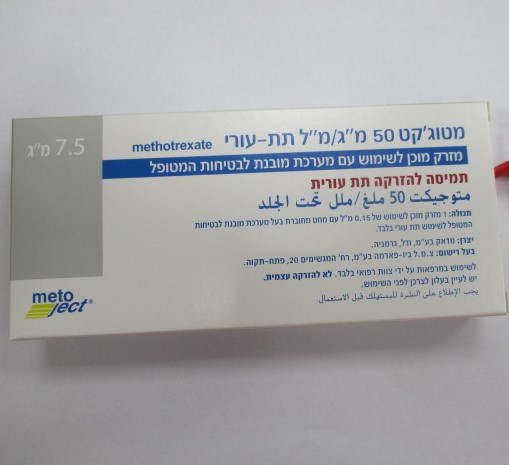Quest for the right Drug

מטוג'קט 50 מ"ג / מ"ל תת עורי METOJECT 50 MG/ML S.C (METHOTREXATE)
תרופה במרשם
תרופה בסל
נרקוטיקה
ציטוטוקסיקה
צורת מתן:
תת-עורי : S.C
צורת מינון:
תמיסה להזרקה : SOLUTION FOR INJECTION
עלון לרופא
מינוניםPosology התוויות
Indications תופעות לוואי
Adverse reactions התוויות נגד
Contraindications אינטראקציות
Interactions מינון יתר
Overdose הריון/הנקה
Pregnancy & Lactation אוכלוסיות מיוחדות
Special populations תכונות פרמקולוגיות
Pharmacological properties מידע רוקחי
Pharmaceutical particulars אזהרת שימוש
Special Warning עלון לרופא
Physicians Leaflet
Adverse reactions : תופעות לוואי
4.8 Undesirable effects Summary of the safety profile Most serious adverse reactions of methotrexate include bone marrow suppression, pulmonary toxicity, hepatotoxicity, renal toxicity, neurotoxicity, thromboembolic events, anaphylactic shock and Stevens- Johnson syndrome. Most frequently (very common) observed adverse reactions of methotrexate include gastrointestinal disorders e.g. stomatitis, dyspepsia, abdominal pain, nausea, loss of appetite and abnormal liver function tests e.g. increased ALAT, ASAT, bilirubin, alkaline phosphatase. Other frequently (common) occurring adverse reactions are leukopenia, anaemia, thrombopenia, headache, tiredness, drowsiness, pneumonia, interstitial alveolitis/pneumonitis often associated with eosinophilia, oral ulcers, diarrhoea, exanthema, erythema and pruritus. Tabulated list of adverse reactions The most relevant undesirable effects are suppression of the haematopoietic system and gastrointestinal disorders. The following headings are used to organise the undesirable effects in order of frequency: Very common (≥ 1/10), common (≥ 1/100 to < 1/10), uncommon (≥ 1/1,000 to < 1/100), rare (≥ 1/10,000 to < 1/1,000), very rare (< 1/10,000), not known (cannot be estimated from the available data) Infections and infestations Uncommon: Pharyngitis. Rare: Infection (including reactivation of inactive chronic infection), sepsis, conjunctivitis. Neoplasms benign, malignant and unspecified (including cysts and polyps) Very rare: Lymphoma (see “description” below). Blood and lymphatic system disorders Common: Leukopenia, anaemia, thrombocytopenia. Uncommon: Pancytopenia. Very rare: Agranulocytosis, severe courses of bone marrow depression, lymphoproliferative disorders (see “description” below). Not known: Eosinophilia. Immune system disorders Rare: Allergic reactions, anaphylactic shock, hypogammaglobulinaemia. Metabolism and nutrition disorders Uncommon: Precipitation of diabetes mellitus. Psychiatric disorders Uncommon: Depression, confusion. Rare: Mood alterations. Nervous system disorders Common: Headache, tiredness, drowsiness. Uncommon: Dizziness. Very rare: Pain, muscular asthenia or paraesthesia/hypoaesthesia, changes in sense of taste (metallic taste), convulsions, meningism, acute aseptic meningitis, paralysis. Not known: Encephalopathy/Leukoencephalopathy. Eye disorders Rare: Visual disturbances. Very rare: Impaired vision, retinopathy. Cardiac disorders Rare: Pericarditis, pericardial effusion, pericardial tamponade. Vascular disorders Rare: Hypotension, thromboembolic events. Respiratory, thoracic and mediastinal disorders Common: Pneumonia, interstitial alveolitis/pneumonitis often associated with eosinophilia. Symptoms indicating potentially severe lung injury (interstitial pneumonitis) are: dry, not productive cough, short of breath and fever. Rare: Pulmonary fibrosis, Pneumocystis jirovecii pneumonia, shortness of breath and bronchial asthma, pleural effusion. Not known: Epistaxis, pulmonary alveolar haemorrhage. Gastrointestinal disorders Very common: Stomatitis, dyspepsia, nausea, loss of appetite, abdominal pain. Common: Oral ulcers, diarrhoea. Uncommon: Gastrointestinal ulcers and bleeding, enteritis, vomiting, pancreatitis. Rare: Gingivitis. Very rare: Haematemesis, haematorrhea, toxic megacolon. Hepatobiliary disorders (see section 4.4) Very common: Abnormal liver function tests (increased ALAT, ASAT, alkaline phosphatase and bilirubin). Uncommon: Cirrhosis, fibrosis and fatty degeneration of the liver, decrease in serum albumin. Rare: Acute hepatitis. Very rare: Hepatic failure. Skin and subcutaneous tissue disorders Common: Exanthema, erythema, pruritus. Uncommon: Photosensitisation, loss of hair, increase in rheumatic nodules, skin ulcer, herpes zoster, vasculitis, herpetiform eruptions of the skin, urticaria. Rare: Increased pigmentation, acne, petechiae, ecchymosis, allergic vasculitis. Very rare: Stevens-Johnson syndrome, toxic epidermal necrolysis (Lyell’s syndrome), increased pigmentary changes of the nails, acute paronychia, furunculosis, telangiectasia. Not known: Skin exfoliation / dermatitis exfoliative Musculoskeletal and connective tissue disorders Uncommon: Arthralgia, myalgia, osteoporosis. Rare: Stress fracture. Not known: Osteonecrosis of jaw (secondary to lymphoproliferative disorders). Renal and urinary disorders Uncommon: Inflammation and ulceration of the urinary bladder, renal impairment, disturbed micturition. Rare: Renal failure, oliguria, anuria, electrolyte disturbances. Not known: Proteinuria. Reproductive system and breast disorders Uncommon: Inflammation and ulceration of the vagina. Very rare: Loss of libido, impotence, gynaecomastia, oligospermia, impaired menstruation, vaginal discharge. General disorders and administration site conditions Rare: Fever, wound-healing impairment. Very rare: Local damage (formation of sterile abscess, lipodystrophy) of injection site following subcutaneous administration. Not known: Asthenia, injection site necrosis, oedema. Description of selected adverse reactions The appearance and degree of severity of undesirable effects depends on the dose level and the frequency of administration. However, as severe undesirable effects can occur even at lower doses, it is indispensable that patients are monitored regularly by the doctor at short intervals. Lymphoma/Lymphoproliferative disorders: there have been reports of individual cases of lymphoma and other lymphoproliferative disorders which subsided in a number of cases once treatment with methotrexate had been discontinued. Subcutaneous application of methotrexate is locally well tolerated. Only mild local skin reactions (such as burning sensations, erythema, swelling, discolouration, pruritus, severe itching, pain) were observed, decreasing during therapy. Reporting of suspected adverse reactions Reporting suspected adverse reactions after authorisation of the medicinal product is important. It allows continued monitoring of the benefit/risk balance of the medicinal product. Any suspected adverse events should be reported to the Ministry of Health according to the National Regulation by using an online form https://sideeffects.health.gov.il

שימוש לפי פנקס קופ''ח כללית 1994
לא צוין
תאריך הכללה מקורי בסל
לא צוין
הגבלות
לא צוין
מידע נוסף
עלון מידע לצרכן
06.12.20 - עלון לצרכן אנגלית 06.12.20 - עלון לצרכן עברית 06.12.20 - עלון לצרכן ערבית 07.06.23 - עלון לצרכן אנגלית 04.04.23 - עלון לצרכן עברית 07.06.23 - עלון לצרכן ערבית 24.07.14 - החמרה לעלון 09.10.18 - החמרה לעלון 19.07.20 - החמרה לעלון 25.05.17 - החמרה לעלון 04.04.23 - החמרה לעלוןלתרופה במאגר משרד הבריאות
מטוג'קט 50 מ"ג / מ"ל תת עורי